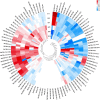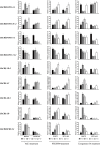Genome-wide characterization of cys-tathionine-β-synthase domain-containing proteins in sugarcane reveals their role in defense responses under multiple stressors
- PMID: 36092401
- PMCID: PMC9453547
- DOI: 10.3389/fpls.2022.985653
Genome-wide characterization of cys-tathionine-β-synthase domain-containing proteins in sugarcane reveals their role in defense responses under multiple stressors
Abstract
Cys-tathionine-β-synthase (CBS) domain-containing proteins (CDCPs) are essential for regulating plant responses to various biotic and abiotic stressors. This study describes the systematic identification and characterization of CDCP family genes in Saccharum spontaneum. A total of 95 SsCDCP genes and eight phylogenetic groups were identified that were distributed over 29 chromosomes of the AP85-441 genome. Most (78/95) SsCDCPs underwent fragment duplication events, and 64 gene pairs were located in synteny blocks. Expression profiling of nine ShCDCPs was also carried out in the Saccharum spp. cultivars ROC22 and MT11-611 that are resistant and susceptible to red stripe, respectively, in response to: (i) Infection by the bacterial pathogen Acidovorax avenue subsp. avenae (Aaa); (ii) abiotic stressors (drought and salinity); and (iii) exogenous salicylic acid (SA) treatment. Members of one gene pair (ShCBSD-PB1-5A and ShCBSD-PB1-7A-1) with a fragment duplication event acted as negative regulators in sugarcane under four stresses, as supported by the significantly decreased expression levels of ShCBSD-PB1-5A (23-83%) and ShCBSD-PB1-7A-1 (15-75%) at all-time points, suggesting that they have functional redundancy. Genes in another pair, ShCBS-4C and ShCBS-4D-1, which have a fragment duplication event, play opposing regulatory roles in sugarcane exposed to multiple stresses, particularly Aaa and NaCl treatments. ShCBS-4C expression was significantly decreased by 32-77%, but ShCBS-4D-1 expression was dramatically upregulated by 1.2-6.2-fold in response to Aaa treatment of both cultivars across all-time points. This result suggested that both genes exhibited functional divergence. Meanwhile, the expression of SsCBSDCBS-5A was significantly upregulated in ROC22 by 1.4-4.6-fold in response to the four stressors. These findings provide important clues for further elucidating the function of ShCDCP genes in sugarcane responding to a diverse range of stresses.
Keywords: Acidovorax avenue subsp. avenae; CBS domain containing proteins (CDCPs); abiotic stress; defense response; gene expression; sugarcane.
Copyright © 2022 Zhou, Li, Lin, Xu, Chu, Wang and Gao.
Conflict of interest statement
The authors declare that the research was conducted in the absence of any commercial or financial relationships that could be construed as a potential conflict of interest.
Figures







Similar articles
-
Identification of ARF transcription factor gene family and its defense responses to bacterial infection and salicylic acid treatment in sugarcane.Front Microbiol. 2023 Sep 7;14:1257355. doi: 10.3389/fmicb.2023.1257355. eCollection 2023. Front Microbiol. 2023. PMID: 37744907 Free PMC article.
-
Global Gene Responses of Resistant and Susceptible Sugarcane Cultivars to Acidovorax avenae subsp. avenae Identified Using Comparative Transcriptome Analysis.Microorganisms. 2019 Dec 19;8(1):10. doi: 10.3390/microorganisms8010010. Microorganisms. 2019. PMID: 31861562 Free PMC article.
-
Genome-wide analysis of mitogen-activated protein (MAP) kinase gene family expression in response to biotic and abiotic stresses in sugarcane.Physiol Plant. 2021 Jan;171(1):86-107. doi: 10.1111/ppl.13208. Epub 2020 Sep 28. Physiol Plant. 2021. PMID: 32909626
-
Systematic and functional analysis of non-specific lipid transfer protein family genes in sugarcane under Xanthomonas albilineans infection and salicylic acid treatment.Front Plant Sci. 2022 Oct 5;13:1014266. doi: 10.3389/fpls.2022.1014266. eCollection 2022. Front Plant Sci. 2022. PMID: 36275567 Free PMC article.
-
Functional divergence of CAD-like family genes in Saccharum complex under biotic and abiotic stress.Plant Cell Rep. 2025 Mar 25;44(4):85. doi: 10.1007/s00299-025-03472-3. Plant Cell Rep. 2025. PMID: 40128384
Cited by
-
Genome-wide identification of R-SNARE gene family in upland cotton and function analysis of GhVAMP72l response to drought stress.Front Plant Sci. 2023 Jul 3;14:1147932. doi: 10.3389/fpls.2023.1147932. eCollection 2023. Front Plant Sci. 2023. PMID: 37465385 Free PMC article.
-
QTL Verification and Candidate Gene Screening of Fiber Quality and Lint Percentage in the Secondary Segregating Population of Gossypium hirsutum.Plants (Basel). 2023 Oct 31;12(21):3737. doi: 10.3390/plants12213737. Plants (Basel). 2023. PMID: 37960093 Free PMC article.
-
Pathogenesis-Related 1 (PR1) Protein Family Genes Involved in Sugarcane Responses to Ustilago scitaminea Stress.Int J Mol Sci. 2024 Jun 12;25(12):6463. doi: 10.3390/ijms25126463. Int J Mol Sci. 2024. PMID: 38928169 Free PMC article.
References
-
- Brindha C., Vasantha S., Arunkumar R. (2019). The response of sugarcane genotypes subjected to salinity stress at different growth phases. J. Plant Physiol. 5 28–33. 10.25081/jpsp.2019.v5.5643 - DOI
LinkOut - more resources
Full Text Sources
Miscellaneous

